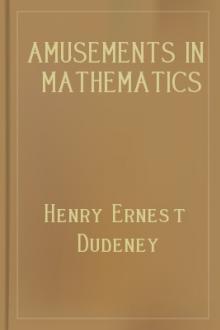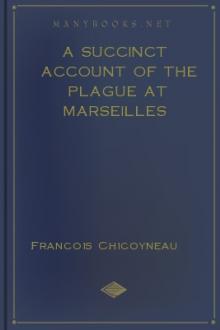Amusements in Mathematics, Henry Ernest Dudeney [books to read to be successful txt] 📗

- Author: Henry Ernest Dudeney
- Performer: 0486204731
Book online «Amusements in Mathematics, Henry Ernest Dudeney [books to read to be successful txt] 📗». Author Henry Ernest Dudeney
But even after these points are all seen there comes in a new difficulty: for although it will be found that all the 8's may be on the backs of the 7's, we cannot have all the 2's on the backs of the 1's, nor all the 4 on the backs of the 3's, etc. There is a great danger, in our attempts to get as many as possible painted alike, of our so adjusting the figures that some particular combination of hymns cannot be represented.
Here is the solution of the difficulty that was sent to the vicar of Chumpley St. Winifred. Where the sign is placed between two figures, it implies that one of these figures is on one side of the plate and the other on the other side.
Of course, if we could increase the number of plates, we might get the painting done for nothing, but such a contingency is prevented by the condition that the fewest possible plates must be provided.
This puzzle appeared in Tit-Bits, and the following remarks, made by me in the issue for 11th December 1897, may be of interest.
The "Hymn-Board Poser" seems to have created extraordinary interest. The immense number of attempts at its solution sent to me from all parts of the United Kingdom and from several Continental countries show a very kind disposition amongst our readers to help the worthy vicar of Chumpley St. Winifred over his parochial difficulty. Every conceivable estimate, from a few shillings up to as high a sum as £1,347, 10s., seems to have come to hand. But the astonishing part of it is that, after going carefully through the tremendous pile of correspondence, I find that only one competitor has succeeded in maintaining the reputation of the Tit-Bits solvers for their capacity to solve anything, and his solution is substantially the same as the one given above, the cost being identical. Some of his figures are differently combined, but his grouping of the plates, as shown in the first column, is exactly the same. Though a large majority of competitors clearly hit upon all the essential points of the puzzle, they completely collapsed in the actual arrangement of the figures. According to their methods, some possible selection of hymns, such as 111, 112, 121, 122,211, cannot be set up. A few correspondents suggested that it might be possible so to paint the 7's that upside down they would appear as 2's or 4's; but this would, of course, be barred out by the fact that a representation of the actual figures to be used was given.
427.—PHEASANT-SHOOTING.—solution
The arithmetic of this puzzle is very easy indeed. There were clearly 24 pheasants at the start. Of these 16 were shot dead, 1 was wounded in the wing, and 7 got away. The reader may have concluded that the answer is, therefore, that "seven remained." But as they flew away it is clearly absurd to say that they "remained." Had they done so they would certainly have been killed. Must we then conclude that the 17 that were shot remained, because the others flew away? No; because the question was not "how many remained?" but "how many still remained?" Now the poor bird that was wounded in the wing, though unable to fly, was very active in its painful struggles to run away. The answer is, therefore, that the 16 birds that were shot dead "still remained," or "remained still."
428.—THE GARDENER AND THE COOK.—solution
Nobody succeeded in solving the puzzle, so I had to let the cat out of the bag—an operation that was dimly foreshadowed by the puss in the original illustration. But I first reminded the reader that this puzzle appeared on April 1, a day on which none of us ever resents being made an "April Fool;" though, as I practically "gave the thing away" by specially drawing attention to the fact that it was All Fools' Day, it was quite remarkable that my correspondents, without a single exception, fell into the trap.
One large body of correspondents held that what the cook loses in stride is exactly made up in greater speed; consequently both advance at the same rate, and the result must be a tie. But another considerable section saw that, though this might be so in a race 200 ft. straight away, it could not really be, because they each go a stated distance at "every bound," and as 100 is not an exact multiple of 3, the gardener at his thirty-fourth bound will go 2 ft. beyond the mark. The gardener will, therefore, run to a point 102 ft. straight away and return (204 ft. in all), and so lose by 4 ft. This point certainly comes into the puzzle. But the most important fact of all is this, that it so happens that the gardener was a pupil from the Horticultural College for Lady Gardeners at, if I remember aright, Swanley; while the cook was a very accomplished French chef of the hemale persuasion! Therefore "she (the gardener) made three bounds to his (the cook's) two." It will now be found that while the gardener is running her 204 ft. in 68 bounds of 3 ft., the somewhat infirm old cook can only make 451/3 of his 2 ft. bounds, which equals 90 ft. 8 in. The result is that the lady gardener wins the race by 109 ft. 4 in. at a moment when the cook is in the air, one-third through his 46th bound.
The moral of this puzzle is twofold: (1) Never take things for granted in attempting to solve puzzles; (2) always remember All Fools' Day when it comes round. I was not writing of any gardener and cook, but of a particular couple, in "a race that I witnessed." The statement of the eye-witness must therefore be accepted: as the reader was not there, he cannot contradict it. Of course the information supplied was insufficient, but the correct reply was: "Assuming the gardener to be the 'he,' the cook wins by 4 ft.; but if the gardener is the 'she,' then the gardener wins by 109 ft. 4 in." This would have won the prize. Curiously enough, one solitary competitor got on to the right track, but failed to follow it up. He said: "Is this a regular April 1 catch, meaning that they only ran 6 ft. each, and consequently the race was unfinished? If not, I think the following must be the solution, supposing the gardener to be the 'he' and the cook the 'she.'" Though his solution was wrong even in the case he supposed, yet he was the only person who suspected the question of sex.
429.—PLACING HALFPENNIES.—solution
Thirteen coins may be placed as shown.

430.—FIND THE MAN'S WIFE.—solution
There is no guessing required in this puzzle. It is all a question of elimination. If we can pair off any five of the ladies with their respective husbands, other than husband No. 10, then the remaining lady must be No. 10's wife.
I will show how this may be done. No. 8 is seen carrying a lady's parasol in the same hand with his walking-stick. But every lady is provided with a parasol, except No. 3; therefore No. 3 may be safely said to be the wife of No. 8. Then No. 12 is holding a bicycle, and the dress-guard and make disclose the fact that it is a lady's bicycle. The only lady in a cycling skirt is No. 5; therefore we conclude that No. 5 is No. 12's wife. Next, the man No. 6 has a dog, and lady No. 11 is seen carrying a dog chain. So we may safely pair No. 6 with No. 11. Then we see that man No. 2 is paying a newsboy for a paper. But we do not pay for newspapers in this way before receiving them, and the gentleman has apparently not taken one from the boy. But lady No. 9 is seen reading a paper. The inference is obvious—that she has sent the boy to her husband for a penny. We therefore pair No. 2 with No. 9. We have now disposed of all the ladies except Nos. 1 and 7, and of all the men except Nos. 4 and 10. On looking at No. 4 we find that he is carrying a coat over his arm, and that the buttons are on the left side;—not on the right, as a man wears them. So it is a lady's coat. But the coat clearly does not belong to No. 1, as she is seen to be wearing a coat already, while No. 7 lady is very lightly clad. We therefore pair No. 7 lady with man No. 4. Now the only lady left is No. 1, and we are consequently forced to the conclusion that she is the wife of No. 10. This is therefore the correct answer.
INDEX.Abbot's Puzzle, The, 20, 161.
—— Window, The, 87, 213.
Academic Courtesies, 18, 160.
Acrostic Puzzle, An, 84, 210.
Adam and Eve and the Apples, 18.
Aeroplanes, The Two, 2, 148.
Age and Kinship Puzzles, 6.
—— Concerning Tommy's, 7, 153.
—— Mamma's, 7, 152.
—— Mrs. Timpkins's, 7, 152.
—— Rover's, 7, 152.
Ages, The Family, 7, 152.
—— Their, 7, 152.
Alcuin, Abbot, 20, 112.
Almonds, The Nine, 64, 195.
Amazons, The, 94, 221.
Andrews, W.S., 125.
Apples, A Deal in, 3, 149.
—— Buying, 6, 151.
—— The Ten, 64, 195.
Approximations in Dissection, 28.
Arithmetical and Algebraical Problems, 1.
—— Various, 17.
Arthur's Knights, King, 77, 203.
Artillerymen's Dilemma, 26, 167.
Asparagus, Bundles of, 140.
Aspects all due South, 137.
Associated Magic Squares, 120.
Axiom, A Puzzling, 138.
Bachet de Méziriac, 90, 109, 112.
Bachet's Square,





Comments (0)